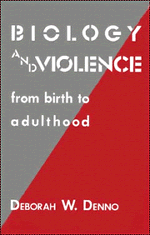Book contents
- Frontmatter
- Contents
- Foreword by Marvin E. Wolfgang
- Preface
- Introduction
- 1 Biological and environmental influences on crime
- 2 Violent criminals as children and as adults
- 3 Intelligence and crime
- 4 Biological and environmental predictors of crime
- 5 Case studies of violent and career criminals
- 6 Biology and responsibility
- Appendix: Selection and distribution of Biosocial Project variables
- References
- Author index
- Subject index
5 - Case studies of violent and career criminals
Published online by Cambridge University Press: 04 August 2010
- Frontmatter
- Contents
- Foreword by Marvin E. Wolfgang
- Preface
- Introduction
- 1 Biological and environmental influences on crime
- 2 Violent criminals as children and as adults
- 3 Intelligence and crime
- 4 Biological and environmental predictors of crime
- 5 Case studies of violent and career criminals
- 6 Biology and responsibility
- Appendix: Selection and distribution of Biosocial Project variables
- References
- Author index
- Subject index
Summary
In the Biosocial Project sample, nearly one quarter of the delinquent males and 12 percent of the delinquent females were violent, and frequently chronic, offenders. Relative to nonoffenders, these individuals had lower tested achievement, they evidenced more disciplinary problems in school, and their behavior was associated with certain biological and environmental disadvantages.
This chapter provides a closer look at the 28 most violent and chronic criminals in the sample and a matched control group of noncriminals in order to detail additional biological and familial factors that could contribute to differences in behavior. Criminals and their controls are compared, using information gathered during home interviews with the Biosocial Project children and their families, as well as written observations and impressions made during the children's medical and psychological examinations. Adult arrest histories are also examined to characterize those who continued to demonstrate problem behaviors after adolescence.
Interviews and observations
Much of the information on the Biosocial Project sample was gathered through extensive home interviews with the child's primary caretaker, usually the mother, and observations of the child. Interviews and observations were conducted by experienced social workers as early as four months after the child's birth and continued every four to six months until the child's eighth birthday. Home interviews provided data on the family's income, living conditions, number of family members, quality of parent–child interactions, and parents' employment status, as well as most of the Perinatal Project data on socioeconomic and household characteristics.
- Type
- Chapter
- Information
- Biology and ViolenceFrom Birth to Adulthood, pp. 96 - 122Publisher: Cambridge University PressPrint publication year: 1990



